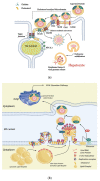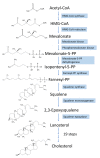Viral Hepatitis, Cholesterol Metabolism, and Cholesterol-Lowering Natural Compounds
- PMID: 35409259
- PMCID: PMC8999150
- DOI: 10.3390/ijms23073897
Viral Hepatitis, Cholesterol Metabolism, and Cholesterol-Lowering Natural Compounds
Abstract
Hepatitis is defined as inflammation of the liver; it can be acute or chronic. In chronic cases, the prolonged inflammation gradually damages the liver, resulting in liver fibrosis, cirrhosis, and sometimes liver failure or cancer. Hepatitis is often caused by viral infections. The most common causes of viral hepatitis are the five hepatitis viruses-hepatitis A virus (HAV), hepatitis B virus (HBV), hepatitis C virus (HCV), hepatitis D virus (HDV), and hepatitis E virus (HEV). While HAV and HEV rarely (or do not) cause chronic hepatitis, a considerable proportion of acute hepatitis cases caused by HBV (sometimes co-infected with HDV) and HCV infections become chronic. Thus, many medical researchers have focused on the treatment of HBV and HCV. It has been documented that host lipid metabolism, particularly cholesterol metabolism, is required for the hepatitis viral infection and life cycle. Thus, manipulating host cholesterol metabolism-related genes and proteins is a strategy used in fighting the viral infections. Efforts have been made to evaluate the efficacy of cholesterol-lowering drugs, particularly 3-hydroxy-3-methylglutaryl coenzyme A (HMG-CoA) reductase inhibitors, in the treatment of hepatitis viral infections; promising results have been obtained. This review provides information on the relationships between hepatitis viruses and host cholesterol metabolism/homeostasis, as well as the discovery/development of cholesterol-lowering natural phytochemicals that could potentially be applied in the treatment of viral hepatitis.
Keywords: HMG-CoA reductase; cholesterol metabolism; hepatitis virus; phytochemicals.
Conflict of interest statement
The authors declare no conflict of interest.
Figures



Similar articles
-
Molecular epidemiology of hepatitis B, C, D and E viruses among children in Moscow, Russia.J Clin Virol. 2004 May;30(1):57-61. doi: 10.1016/j.jcv.2003.08.009. J Clin Virol. 2004. PMID: 15072755
-
Recent Advances in Protective Vaccines against Hepatitis Viruses: A Narrative Review.Viruses. 2023 Jan 12;15(1):214. doi: 10.3390/v15010214. Viruses. 2023. PMID: 36680254 Free PMC article. Review.
-
[Viral hepatitis A to E--diagnosis, clinical aspects and therapy].Ther Umsch. 1994 Aug;51(8):530-7. Ther Umsch. 1994. PMID: 7940409 German.
-
Prevalence of hepatitis A virus, hepatitis B virus, hepatitis C virus, hepatitis D virus and hepatitis E virus as causes of acute viral hepatitis in North India: a hospital based study.Indian J Med Microbiol. 2013 Jul-Sep;31(3):261-5. doi: 10.4103/0255-0857.115631. Indian J Med Microbiol. 2013. PMID: 23883712
-
Molecular biology of viral hepatitis and hepatocellular carcinoma.Compr Ther. 1993;19(5):188-96. Compr Ther. 1993. PMID: 8275664 Review.
Cited by
-
Rubensteroid A, a new steroid with antibacterial activity from Penicillium rubens AS-130.J Antibiot (Tokyo). 2023 Sep;76(9):563-566. doi: 10.1038/s41429-023-00634-x. Epub 2023 May 31. J Antibiot (Tokyo). 2023. PMID: 37258804
-
Targeting chronic liver diseases: Molecular markers, drug delivery strategies and future perspectives.Int J Pharm. 2024 Jul 20;660:124381. doi: 10.1016/j.ijpharm.2024.124381. Epub 2024 Jun 23. Int J Pharm. 2024. PMID: 38917958 Free PMC article. Review.
-
Pollutants-mediated viral hepatitis in different types: assessment of different algorithms and time series models.Sci Rep. 2024 Sep 10;14(1):21141. doi: 10.1038/s41598-024-72047-1. Sci Rep. 2024. PMID: 39256598 Free PMC article.
-
An overview of the role of Niemann-pick C1 (NPC1) in viral infections and inhibition of viral infections through NPC1 inhibitor.Cell Commun Signal. 2023 Dec 14;21(1):352. doi: 10.1186/s12964-023-01376-x. Cell Commun Signal. 2023. PMID: 38098077 Free PMC article. Review.
-
Effect of dyslipidemia on HBsAg clearance in nucleos(t)ide analogues-experienced chronic hepatitis B patients treated with peginterferon alfa.BMC Infect Dis. 2024 Nov 11;24(1):1273. doi: 10.1186/s12879-024-10093-w. BMC Infect Dis. 2024. PMID: 39528941 Free PMC article.
References
-
- Stanaway J.D., Flaxman A.D., Naghavi M., Fitzmaurice C., Vos T., Abubakar I., Abu-Raddad L.J., Assadi R., Bhala N., Cowie B., et al. The global burden of viral hepatitis from 1990 to 2013: Findings from the Global Burden of Disease Study 2013. Lancet. 2016;388:1081–1088. doi: 10.1016/S0140-6736(16)30579-7. - DOI - PMC - PubMed
-
- Selitsky S.R., Dinh T.A., Toth C.L., Kurtz C.L., Honda M., Struck B.R., Kaneko S., Vickers K.C., Lemon S.M., Sethupathy P. Transcriptomic Analysis of Chronic Hepatitis B and C and Liver Cancer Reveals MicroRNA-Mediated Control of Cholesterol Synthesis Programs. mBio. 2015;6:e01500–e01515. doi: 10.1128/mBio.01500-15. - DOI - PMC - PubMed
Publication types
MeSH terms
Substances
LinkOut - more resources
Full Text Sources
Medical

